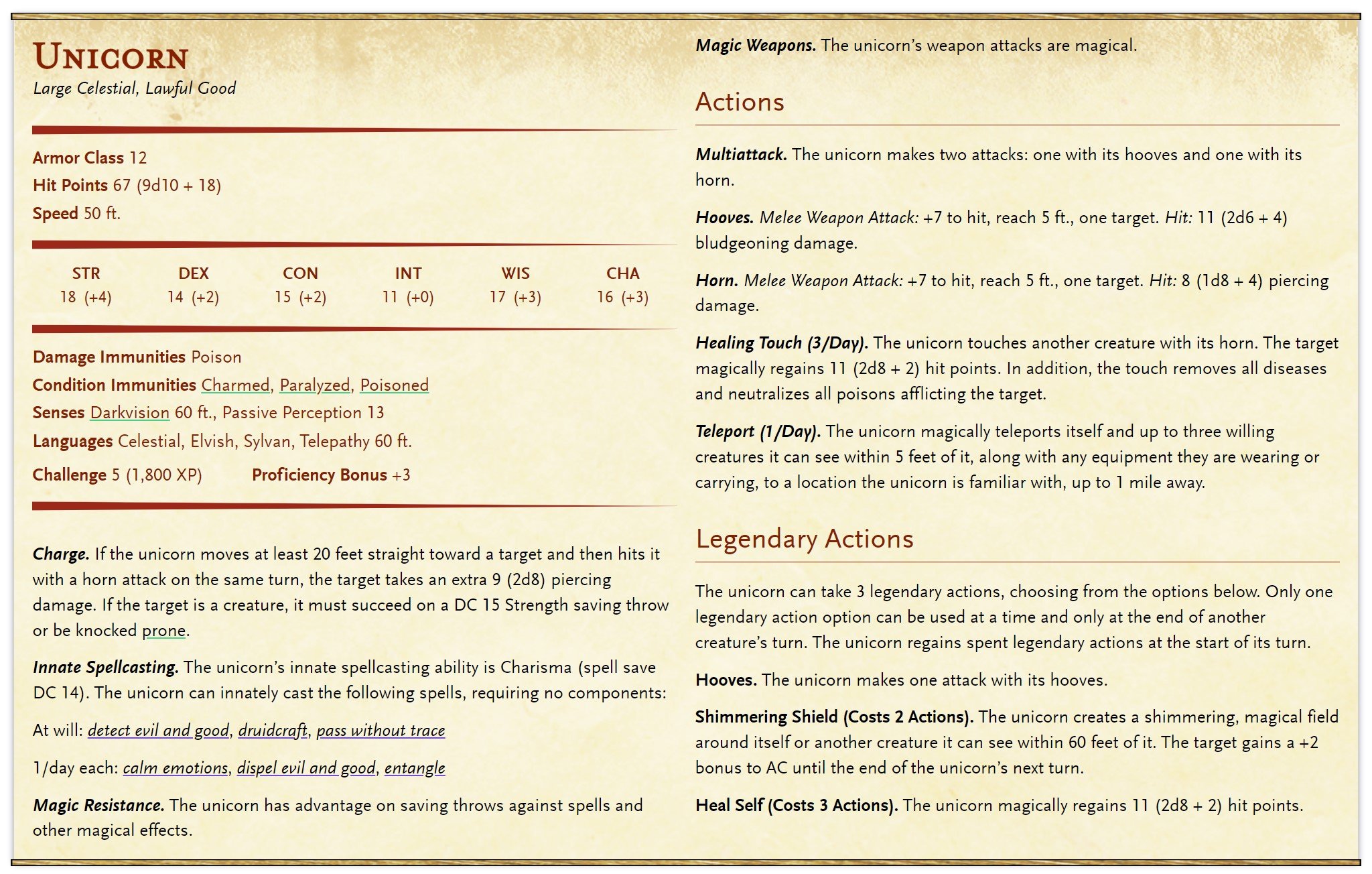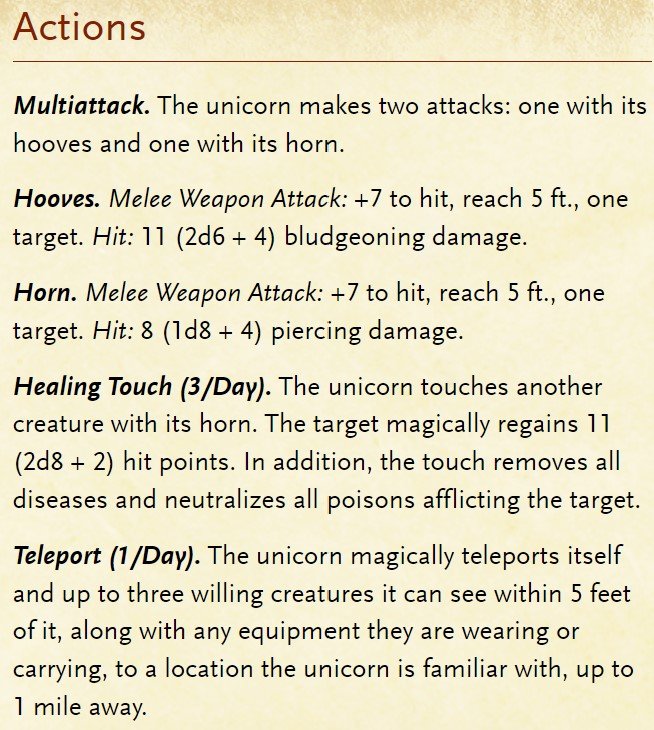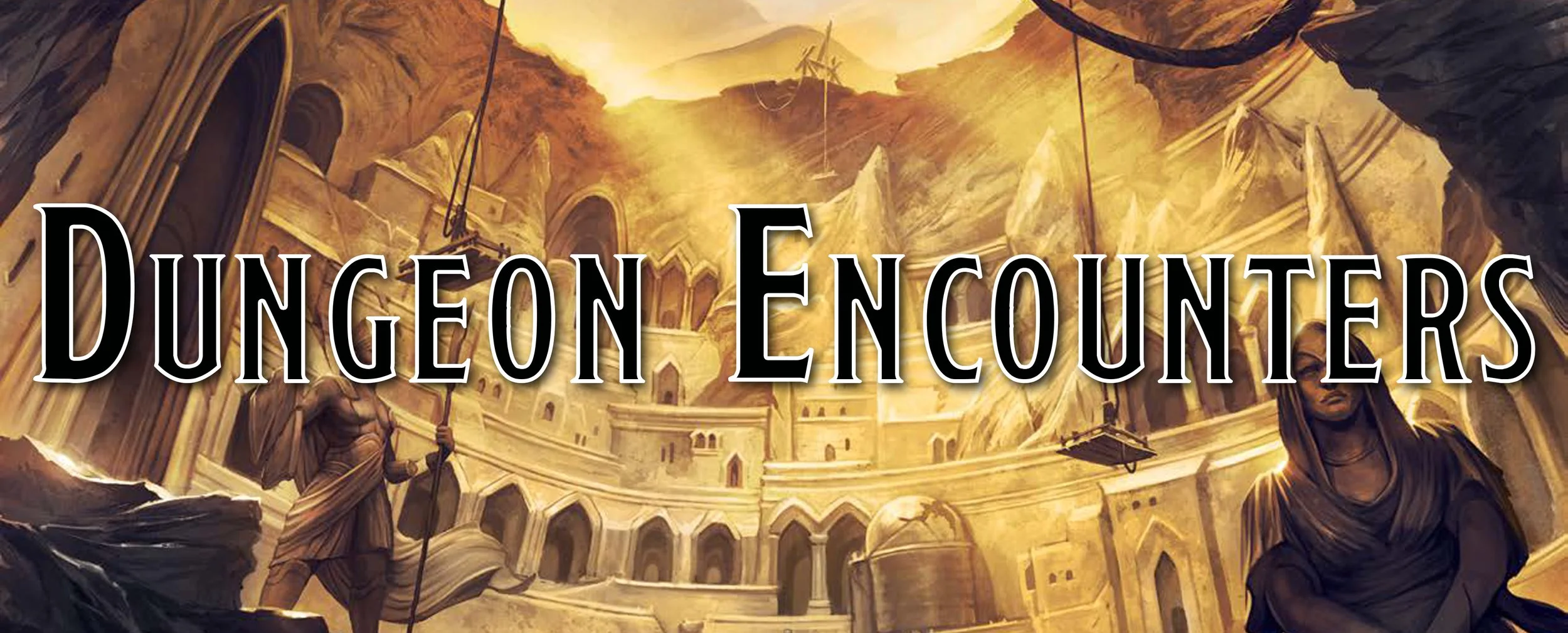Deconstructing a Monster's Stat Block
Monster Manual, 2014 Wizards of the Coast
I’ve had a lot of people ask me how to make a monster stat block - and not just for help on whether a monster is an aberration or a monstrosity, whether it should have spells, how many hit points it should have, or other common questions. Instead, it’s questions like where do these numbers come from, how do you figure out the to hit, and why does one monster deal 2d8 with a longsword and another deals 1d8?
One of the reasons why you could have some confusion in regards to this is that 5e’s monster-building rules do not follow the character creation rules, something that was common in 3rd edition and earlier. Instead, you create a monster ‘from scratch’ as it were - only relying on what you’ve seen from other monsters and what is available in the Dungeon Master’s Guide.
So, let’s go ahead and start breaking down a stat block, line-by-line. For our example, I will be using the Unicorn stat block found in the Monster Manual. Though, if you are more curious about how to create a monster, as opposed to how a stat block works, check out my post Making a Boss.
Monster Manual, 2014 Wizards of the Coast
Name Traits
Our first line can be the easiest and hardest part for me. This one is pretty easy to understand, it’s the name of your monster. Once you have that figured out, which can take me a while to think of something evocative and useful, now you can really begin.
Size & Traits
Up next is a monster’s size, type, and alignment. There are six different sizes you can pick for your monster, starting with the smallest you have Tiny, Small, Medium, Large, Huge, and Gargantuan. The size of a creature informs a few things that will come up later like Hit Dice, number of damage dice (sort of), and the creature’s reach.
After that, you have to decide on the creature’s type between Aberration, Beast, Celestial, Construct, Dragon, Elemental, Fey, Fiend, Giant, Humanoid, Monstrosity, Ooze, Plant, and Undead. If you are curious about the differences between all of these, make sure to check out the beginning pages of the Monster Manual as it goes over their differences. The main thing is that Monstrosity is a catch-all, so if you aren’t immediately sure what a creature is, it will probably end up in there.
Once you have that figured out, you then decide on the creature’s alignment. This has ten options with Lawful Good, Lawful Neutral, Lawful Evil, Neutral Good, Neutral, Neutral Evil, Chaotic Good, Chaotic Neutral, Chaotic Evil, and Unaligned. Unaligned is largely reserved for beasts, constructs, and monstrosities that are mindless and make no real ‘moral decisions’.
In recent years, Wizards has also been adding “typically” before their alignments unless it is for unique creatures, like NPCs. This is to give GMs greater freedom in how they wish to run creatures, though it has never been something that is needed. If you wanted a lawful good demon, no book out there ever said you couldn’t do it.
Armor Class
The default for deciding your AC is 10 plus the creature’s Dexterity modifier. If you want your monster to have a higher AC, you can either give them armor to wear or simply pick an appropriate number for your monster and add “(Natural Armor)” after it - like Ankheg or Bulette.
Hit Points
Up next are hit points, one of the harder things to ascertain when first making monsters. The secret, really, is to just look at the different monsters of the same size and in the same CR as your monster. While there is a chart in the Dungeon Master’s Guide, it is unreliable and doubles, triples, and even quadruples the hit points of other monsters of similar CR.
The other thing to keep in mind is that your Hit Die is based on your size, unlike for players whose Hit Die is based on their class. Tiny creatures have a d4, Small d6, Medium d8, Large d10, Huge d12, and Gargantuan d20. In addition, remember that the average of a hit die is not a whole number, but rather a fraction. So, a d4 will have an average of 2.5, d6 3.5, d8 4.5, d10 5.5, d12 6.5, and d20 10.5.
Though, if you have an odd number of Hit Die, the total hit points won’t include half of a hit point, you round down. For example, the Unicorn has 9d10+18 hit points, which would end up actually being 67.5, but you round down to the nearest whole - 67 hit points.
Looking back at the example again, you’ll notice there is a modifier to the hit dice. These bonus hit points are the same way that players get bonus points on top of their hit dice, though you don’t take the monster’s CR as its level (like how players use their level), instead you take the monster’s hit dice and multiply it by their Constitution modifier. For example, the unicorn has a +2 constitution modifier, so you multiply that value by its hit die (9) for a total of 18 for those bonus hit points.
Speed
The next value is a simple thing, deciding how fast you want your monster to be. Most creatures will have a speed around 30 feet, though quadrapeds will typically have more, like the unicorn with a speed of 50 feet. On the other hand, if the creature doesn’t have any proper means of movement, then they will have a much slower speed. There are four types of speed to consider, normal walking speed, flying speed, swim speed, and a burrow speed. If a creature can fly, and doesn’t rely on wings, you’d add a tag after their speed (hover) like in the ghost’s stat block.
Ability Scores
Every monster has a score for each ability, along with its corresponding modifier. There is no easy way of assigning these values beyond referencing what other monsters have. There are a few things to keep in mind, though. Most monsters won’t have an ability over 18 before CR 5, they won’t have an ability over 20 before CR 8, and after that it greatly depends on the monster.
Just remember that every monster needs give and take. If you make them excellent in one ability, they shouldn’t be excellent in all abilities. Of course, the opposite is also true, the monster shouldn’t be miserable in all its abilities.
Also, keep in mind, if you want your monster to be good in melee, it needs to be good in either Strength or Dexterity. If you want it to cast spells, it needs to be good in either Intelligence, Wisdom, or Charisma. If it is going to be taking a lot of hits, make sure it has a good Constitution.
Saving Throws
While our unicorn doesn’t have any saving throws, and most creatures don’t, you can give it to your monsters without adjusting the creature’s CR. Simply take the creature’s ability modifier and add their proficiency bonus. While you shouldn’t give a monster proficiency in every saving throw, you can follow the same rules that players have. They get proficiency in a common saving throw (Dexterity, Constitution, or Wisdom) and proficiency in a rare saving throw (Strength, Intelligence, or Charisma).
Skills
Our unicorn, once again, does not have any skills. You can give skills as you like and it won’t affect a creature’s CR. These skills should be thematic, a scholar should get proficiency in history, religion, or nature, a big strong warrior could have athletics, etc. These rarely, besides athletics or acrobatics, show up in combat. Though, I have come up with ways to Charisma in combat.
Damage Adjustments
The next three lines in a stat block are Damage Vulnerabilities, Damage Resistances, and Damage Immunities. Each of these lines augments how a monster handles different types of damage thrown at it. Most monsters don’t have any entry in this section of their stat block. If you do decide, it should be an element that is associated with the monster. It wouldn’t make sense for an orc warrior to be immune to acid damage, but it could make sense if they were blessed by their deity to be resistant to non-magical bludgeoning, piercing, and slashing damage.
If you choose to make a monster have a damage vulnerability, be very aware that its hit points will deplete much faster due to taking a lot more damage from the player’s attacks. As a counter, you can slightly increase the monster’s hit points if it is a common damage type, like slashing or fire, or leave it be if it is a rarer damage type like thunder.
Condition Immunities
Up next is a monster’s ability to ignore certain conditions, something that many monsters will not have. Our unicorn can ignore being charmed, paralyzed, and poisoned. This should be thematic to the creature, it wouldn’t make sense that a ghost or ooze could be knocked prone, nor that a creature immune to poison damage could be poisoned.
Senses
Every creature has to see the world, even if they are blind and merely sense it. This is where you put if a creature has darkvision, blindsense, tremorsense, or whatever sense they might have. In addition, at the end of it, put in the creature’s passive Perception - which is just 10 plus their Wisdom modifier or their Perception modifier if they have that skill. Most creatures’ passive Perception is very low, making it easy for rogues to sneak about them.
Languages
Many creatures have the ability to speak or communicate with each other, this section is where you add in a creature’s languages. If you are making a generic stat block, like for a fighter, you don’t have to add in specific languages but rather add that a creature can speak a number of languages, typically 1 plus their Intelligence modifier (minimum of 1).
Challenge Rating & Proficiency Bonus
A creature’s CR is based on the averages of their offensive and defensive abilities. A challenge rating consists of two numbers, their CR and its associated XP. After that, in newer sourcebooks, is the creature’s Proficiency Bonus. This number was once hidden in the older books, though could be inferred by looking at the creature’s CR and their various bonuses. A monster’s Proficiency Bonus follows the same path as the players, but you use its CR instead of level or hit die, ergo it starts out at +2 and then at CR 5, the monster has a +3 bonus, CR 9 +4, CR 13 +5, CR 17 +6, etc. Since a monster can go up to CR 30, it increases its Proficiency Bonus to +7 at CR 21, +8 at CR 25, and +9 at CR 29.
Abilities
A monster can have a wide variety of abilities and they are all listed here so long as it doesn’t take an action, bonus action, reaction, lair action, or a legendary action. This is… slightly wrong when we look at older books as spellcasting was once included in this section, and most spells take one of those actions, but has since been moved to the Actions section while ignoring spells that require bonus actions or reactions.
If you want to follow newer monster guidelines, move spells into the Actions block, limit the total number of spells a creature knows to just a few, and give them a few special abilities that aren’t quite spells, but still magical in nature.
Our unicorn has some special abilities, like dealing extra damage when it charges, ability to resist magic, and that it’s hooves are magical when they hit you in the face.
Actions, Bonus Actions, and Reactions
One of our last sections focuses on all the abilities that a monster will use in combat separated by if it takes an action, a bonus action, or a reaction. Many monsters will have a unique multiattack action that they can take, which will allow them to take multiple of their ‘actions’ as a single action.
When coming up with the To Hit for an attack, you will take the monster’s Strength or Dexterity modifier and then add their Proficiency Bonus. As for damage, unless the monster is using a specific weapon, in which case you use its normal damage die, you come up with the damage dice you need for the monster to have based on the number of attacks they get and the average damage they get for their CR.
A general rule of thumb, that isn’t always followed, is that Large and larger monsters get an extra die of damage to their attacks. So this means Tiny, Small, and Medium creatures only get a single die for their damage, while Large creatures get two, Huge get three, and Gargantuan get four extra damage die. For example, a frost giant is a huge creature and uses a greataxe. A greataxe’s normal damage is only 1d12, but because it is two sizes larger than Medium, it gets two extra dice to add to its damage for 3d12 damage with its greataxe, plus its impressive Strength modifier of 6.
Legendary Actions & Mythic Actions
Our final section are the special actions that a monster gets that is reserved for elite monsters and bosses. These special actions should be taken into account when calculating a monster’s average offensive and defensive abilities for its CR.
These abilities should be closely tied to the monster’s theme and should offer the monster more than just extra damage, but new ways to interact with the battlefield. In addition, while every monster with Legendary Actions has 3 action points that they can spend in between their turns, for larger groups, I recommend increasing the number of action points they get equal to the number of players minus 1, with a minimum of 3 action points. So for a six party table, the boss would have 5 action points, while for a three party table, the boss would have a minimum of 3 action points.
Adding it all Together
Now that we have gone through, line-by-line, a monster’s stat block - hopefully you have a better understanding of how everything ties together. I know a lot of things in a monster stat block don’t offer very good guidelines, like determining a monster’s ability scores, but this is why you should always be referencing other monsters of similar sizes, CR, and abilities.
Like what we are doing here?
Support us on Patreon!
You’ll get early access to deep dives, the Homebrew Hoard featuring 500+ monsters, Monster Thursdays, ad-free articles, and more!
Follow us on Twitter to keep up to date on everything we talk about!



















